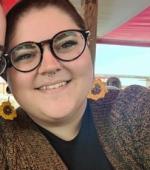Alaura Custard

Alaura Custard is a student at University of Kansas currently completing her research at U.S. Geological Survey, Earthquake Science Center under Dr. Ian Stone & Dr. Erin Wirth.
The amplification of earthquake shaking in sedimentary basins is a major cause of seismic hazard. Often, the ground motions within a basin can be increased by a factor of two or more. While sedimentary basins beneath cities like Los Angeles and Seattle have been studied to characterize basin amplifications, the Tualatin Basin near Portland has not been very well studied. Recently it was discovered that the basin is much deeper than originally thought. The proximity of the Tualatin basin to the Cascadia subduction zone and other large faults has raised concerns about the amplification possible in this basin. Using ambient seismic data collected from broadband seismometers, this project will apply common seismic hazard analysis methods to better characterize the Tualatin basin’s amplification of seismic waves.
Communication Skills
June 28th, 2022
A lot of my family and friends are not scientists, meaning I often need to explain what I’m doing in a way that non-scientists will understand. This exercise wasn’t too hard for me, but I still feel it is a good idea to have a script that I can reference when someone asks me “what’s your internship for?” Even in my first week in the office, anyone I met asked me what I was researching, although the audience in the USGS and PNSN office can understand more of the science jargon. Communication is an extremely important skill in science, one that is often overlooked. It’s our responsibility as scientists to be able to communicate our findings in a way that the rest of the world can understand.
Broadband Stations in Tualatin Basin
June 28th, 2022
The data that I will be working with was collected from 8 broadband stations in and around the Tualatin basin (just west of Portland, OR). I haven’t done much with the data yet, but something I’ve noticed is that TAUL1 has had some issues with collecting north and up components, and TUAL6 has little to no signal at all. TUAL6 is at a higher elevation and is a bit further away from people, but it has very little noise. I think I am one of the first people to look at this data, since it was collected within the last couple years. I’ll be starting with raw data, but it’s not too hard to filter in python (only a couple of lines). I will have to find viable windows of noise that have few large disruptions, which I think will either take some time or some fancy coding.
One of the skills on the mentoring rubric that I feel I need to work on is maintaining a lab notebook. In a perfect world, I would keep notes of what I’m doing to my data, what happens as a result, reflections on these results, next steps, etc. It’s important to be able to come back to your work and not spend a lot of time figuring out where you left off. I have been keeping a word doc open anytime I’m in the office so I can easily write down anything I feel I need to remember, or just what my goal is for the day. I’ve also been trying to keep a notebook where I write down my actual plans on what I’m doing with the data. This one is more specific on techniques and methods, where my word doc is a quick refresher if I get sidetracked.

Goals for my Summer
June 28th, 2022
First and foremost, I want to learn more about seismology! I haven’t had any exposure to seismology before, so I’ve already learned so much about the basics just from the orientation week. I hope to learn more specifics about ambient noise in seismology through my research. Over the course of my internship, I also want to become more confident coding in python. I’ve mostly been working in Matlab, so I feel I have the coding mindset but need to translate it to python. Both goals are long term and once I finish my internship, if I can code in python and tell you all about ambient noise, I feel like I will have accomplished them!


